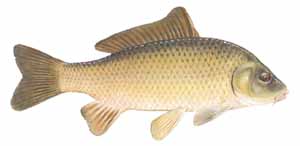Common Carp (Cyprinus carpio)
- Other Names
- German Carp, European Carp
- Description
- Nongame species, no bag or size limits except on Lady Bird Lake
Cyprinus is Greek, and carpio is Latin; both words mean "carp." The common carp is a heavy-bodied minnow with barbels on either side of the upper jaw. Typically, color varies from brassy green or yellow, to golden brown, or even silvery. The belly is usually yellowish-white. The dorsal fin with 17-21 rays, and the anal fin both have a heavy toothed spine. Individuals 12-25 inches in length and weighing up to 8-10 pounds are common, although they can grow much larger. Common carp may live in excess of 47 years and weigh over 75 pounds. The all-tackle world record was landed in 1987 from Lac de St. Cassien, France, and weighed in at 75 pounds 11 ounces. - Life History
- Although carp are generally considered a nuisance by North American anglers, they are highly prized as sportfish in Europe, as they are often excellent fighters. A growing number of anglers in the US are becoming interested in carp as a sportfish. Although flavor varies with the quality of the water from which fish were captured, their sheer abundance has made them an important food fish in some areas.
- Distribution
- Common carp are native to temperate portions of Europe and Asia. They were first introduced into North America in 1877. At that time they were considered so valuable that the precious brood stock was fenced and guarded. Since that time countless introductions both intentional and unintentional have allowed Cyprinus carpio to become one of the most widely distributed fish species in North America, ranging from central Canada to central Mexico, and from coast to coast. In Texas, common carp are ubiquitous.
- Other
- Although carp are generally considered a nuisance by North American anglers, they are highly prized as sportfish in Europe, as they are often excellent fighters. A growing number of anglers in the US are becoming interested in carp as a sportfish. Although flavor varies with the quality of the water from which fish were captured, their sheer abundance has made them an important food fish in some areas. The Texas rod-and-reel record is currently 43.13 pounds. The North American record exceeds 57 pounds.
